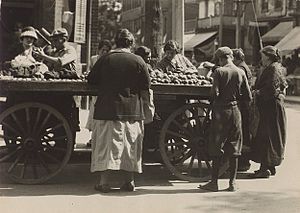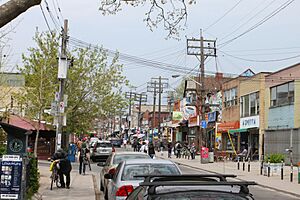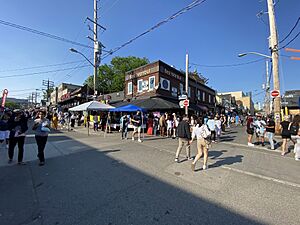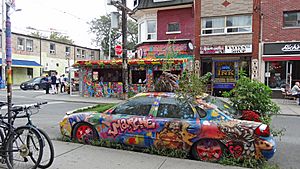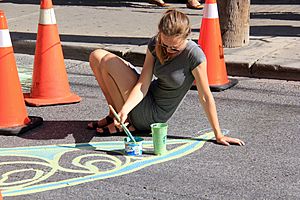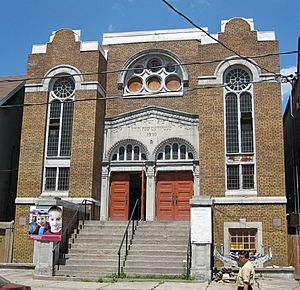Kensington Market facts for kids
Quick facts for kids
Kensington Market
|
|
|---|---|
|
Neighbourhood
|
|
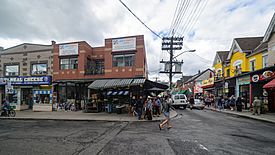
Kensington Market at street level from Baldwin Street and Kensington Avenue
|
|
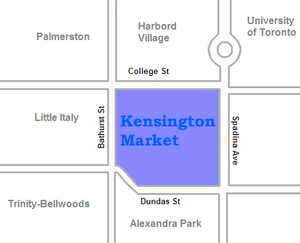 |
|
| Country | |
| Province | |
| City | Toronto |
| Designated: | 2006 |
Kensington Market is a super cool and unique neighbourhood in Downtown Toronto, Ontario, Canada. It's an older area and one of Toronto's most famous spots. In November 2006, it was named a National Historic Site of Canada. This means it's a special place in Canada's history! Many people have taken photos of Kensington Market because it's so colourful and lively.
The neighbourhood is roughly bordered by College Street to the north, Spadina Avenue to the east, Dundas Street West to the south, and Bathurst Street to the west. Most of its awesome shops, cafes, and other attractions are found on Augusta Avenue, Nassau Street, Baldwin Street, and Kensington Avenue. Besides the market, you'll find many beautiful Victorian homes, the Kensington Community School, Bellevue Square park, and Toronto Western Hospital.
Contents
Kensington Market's Past: A Journey Through Time
How Kensington Market Began
The story of Kensington Market started way back in 1815. A man named George Taylor Denison, who was a soldier, bought a large piece of land. This land stretched from where Queen Street West is today all the way to Bloor Street. He used a part of this land, now Bellevue Square Park, for his volunteer cavalry troop to practice.
Later, in the 1850s, Denison's large estate was divided into smaller pieces. In the 1880s, many small houses were built here for immigrants from Ireland and Scotland. These homes are called Victorian row houses. They are still standing today and have been home to many different groups of people over the years.
A Home for Newcomers
In the early 1900s, many Jewish and Italian immigrants moved to Kensington Market. They came from a crowded area of Toronto called "The Ward." They wanted more space and better homes. Kensington Market became known as "the Jewish Market."
Jewish shop owners opened small businesses like tailor shops, fur stores, and bakeries. In the 1920s and 1930s, about 60,000 Jewish people lived in and around Kensington Market. They had over 30 synagogues in the area. The market always sold items from many different countries.
After World War II: A Changing Community
After World War II, many Jewish families moved to other parts of Toronto. In the 1950s, many immigrants from the Azores (islands near Portugal) came to the area. They were escaping political problems in their home country.
Later, new waves of immigrants arrived from the Caribbean and East Asia. This made Kensington Market even more diverse! The Vietnam War also brought many American refugees to the neighbourhood. By the 1980s and 1990s, people from Central America, Somalia, Ethiopia, Sudan, Iran, Vietnam, and Chile also made Kensington Market their home. Today, Chinese people are the largest ethnic group, partly because Chinatown is very close by.
Keeping Kensington Market Special
In the 1960s, there were plans to tear down the small houses and build large apartment buildings. But these plans stopped when David Crombie became Mayor of Toronto. He wanted to protect the unique feel of the neighbourhood.
In the mid-1990s, some stores closed during a tough economic time. But new immigrant business owners brought fresh ideas and ethnic foods to the market. This helped Augusta Avenue become lively again.
Kensington Market is now a popular place for tourists. Many artists and writers also live here. Even though land prices have gone up, Kensington Market is still a place for working-class families and immigrants. In 2021, a local group bought a building to keep rents affordable for residents.
Kensington Market is protected by special rules to keep its unique atmosphere. In 2006, it was officially named a National Historic Site of Canada. Toronto's city plan also makes sure that any new buildings fit in with the neighbourhood's special look. This means new buildings must be low, have shops at street level, and allow goods to be displayed outside. These rules help keep Kensington Market unique for everyone to enjoy!
What Makes Kensington Market Unique?
Cars and People: Sharing the Streets
The narrow streets in Kensington Market can be tricky for drivers and parking. On Saturdays and some afternoons, people often walk right in the middle of the street! Many residents in Kensington Market prefer to walk to work. In fact, more than a third of them do! This is much higher than in other parts of Toronto.
Since 2004, the neighbourhood has held "Pedestrian Sunday" events. On these special Sundays, parts of Augusta Street, Baldwin Street, and Kensington Avenue are closed to cars. The streets become a big party with live music, dancing, street theatre, and games. It's a great way to experience the market without traffic!
Shops and Food: A World of Flavours
Kensington Market is full of amazing food stores. You can find all kinds of meats, fish, and fresh produce. There are also many bakeries, spice shops, and cheese stores. You can buy new and used clothes, and find discount items. The market is also home to many restaurants with foods from all over the world.
A cool thing about the buildings here is that many have extensions built onto the front. This is usually not allowed in other places, but it adds to Kensington's unique look. In recent years, some fancy cafes and restaurants have opened, but the market still keeps its old charm.
Cool Landmarks and Art
Kensington Market has some interesting landmarks. These include the Number 8 Fire Station and Tom's Place. Bellevue Square Park has a statue of the actor Al Waxman. Percy Faith, a famous musician from the 1950s, lived on Baldwin Street as a child. People say his uncle, a master violinist, played music at their house, and crowds would gather outside to listen!
A fun, temporary landmark is the Garden Car. It's been in Kensington Market since 2007. This car is a public art piece that also works as a community garden. It was created by a group called "Streets are for People."
A Hub for Different Ideas
Kensington Market is known for its unique and sometimes rebellious spirit. You might see groups like Trotskyists sharing their ideas. Over the years, several alternative bookstores have been here, like Who's Emma and Uprising Books.
The famous independent bookstore, This Ain't the Rosedale Library, also moved to Kensington Market for a few years. The neighbourhood has also been home to cool performance spaces like Bread & Circus and Double Double Land, which helped create a lively arts scene.
Kensington Market's Culture and Community
Fun Festivals and Events
One of the biggest events is the annual "Kensington Market Winter Solstice Festival." It used to be called the "Festival of Lights." This parade happens in December during the Winter Solstice, which is the longest night of the year. It features giant puppets, fire-breathers, stilt-walkers, and samba musicians. It was started in 1987 to celebrate the return of the sun. Many artists and groups, like the Samba Squad and Clay & Paper Theatre, take part. The parade often ends with a concert.
The Pedestrian Sundays festival, mentioned earlier, is another popular event. The streets close to cars on several Sundays in the summer. This festival brings many people to party in the streets with bands and street food.
Bellevue Square Park also hosts many concerts and festivals during the late spring and summer.
A Diverse Community
Kensington Market is a very diverse place, meaning people from many different backgrounds live here. Because it's so close to Chinatown, many people of Chinese heritage live in Kensington. You'll also find people from other parts of Asia, Latin America, Africa, and Europe. This mix of cultures makes Kensington Market a truly special and welcoming place.
Places of Worship
Two synagogues from the early 1900s are still in the market today. These are Anshei Minsk on St. Andrews Street and the Kiever Synagogue on Bellevue Avenue. They remind us of the area's history as a centre for Toronto's Jewish community.
Kensington Market is also linked to the Rastafari movement. You can find several stores selling Rastafarian cultural items. The Winter Solstice Festival is also an important gathering for Ontario's pagan community.



